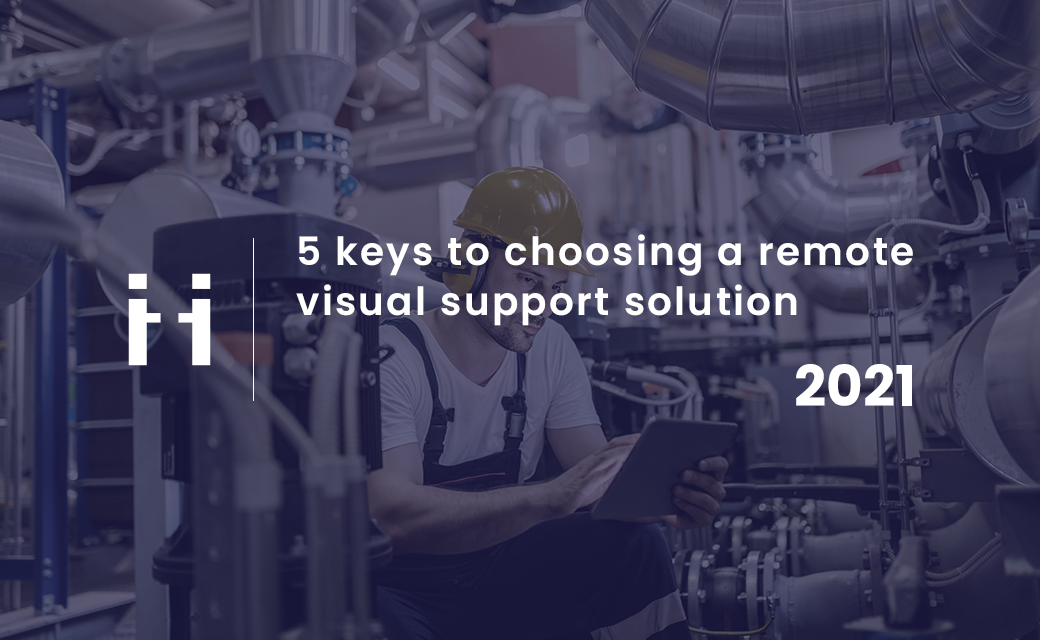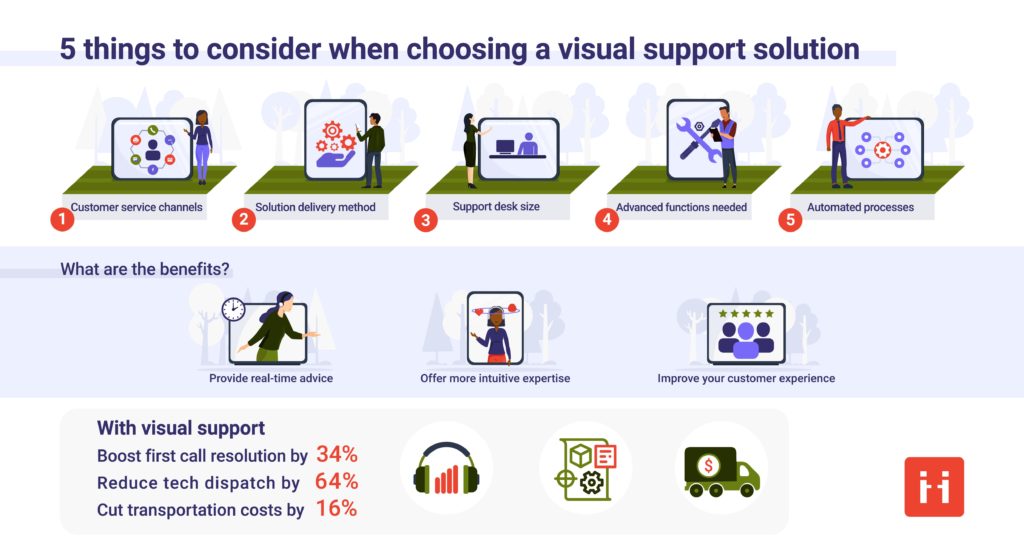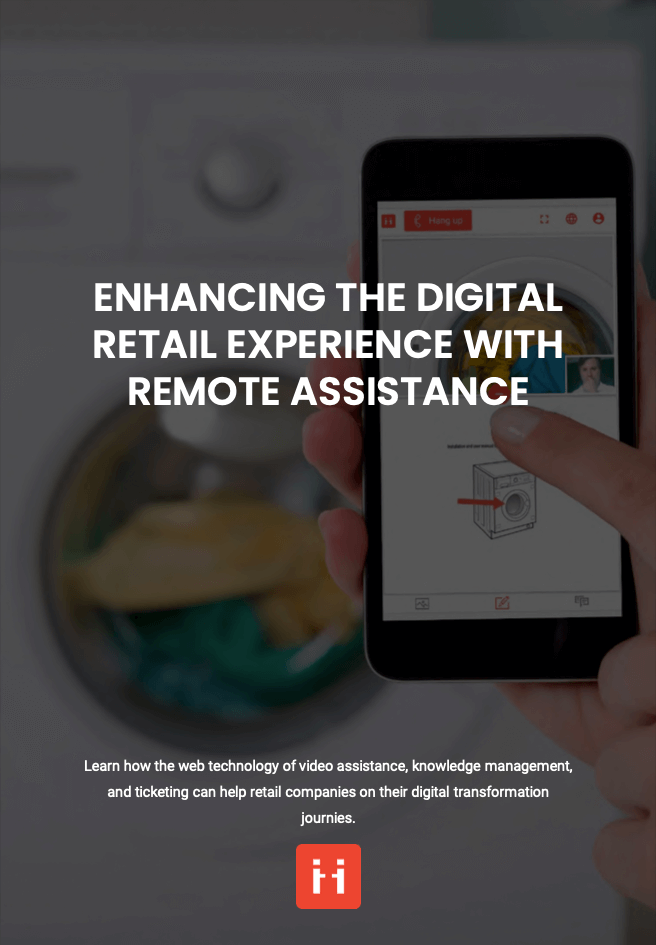
Share this article
Share this article
Remote visual support and AR are two vastly emerging technology redefining customer service and the traditional approach to customer support, with a predicted 1.9 billion active monthly users by 2022. Many such solutions have so far been welcomed on the market, all with functions enabling support teams to provide customers with quick issue identification and tailored personal assistance, while increasing customer service teams’ performances. Yet, what are the considerations you should look at when selecting the perfect remote visual support solution for your business?
Remote visual support is an innovative technology, revolutionizing everyday customer service and customer support practices thanks to features such as live video support and AR.
With these features, the support agent can see exactly what the customer sees during the consultation, making it easier for them to understand the issue the customer is facing, uncover its root cause, and find a solution in a matter of minutes. Finding the right remote inspection tool becomes, then, mandatory. No time is wasted on asking convoluted questions, no pressure is put on the customer to fix the issue on their own.
Remote visual support can also be used to provide assistance to field agents during field tech support services. These services aim to resolve technical problems that a business, worksite, or individual customer is facing.
With remote visual assistance, the support team or expert can provide the customer or technician with real-time advice and more intuitive expertise while improving the company’s customer service.
Augmented Reality is one of the most eminent features of remote visual support. With its ability to overlay one’s surroundings and objects through smartphones and mobile devices, AR merges reality with live video streaming. Through real time broadcasting of the customer’s surroundings all the way to the support team’s office, AR serves as a visual guide on the customer’s device with a support agent accompanying them through every step of the way to reaching the best, most relevant solution. Rather than meticulously explaining every action that needs to be undertaken, the remote expert can simply show the customer what to do to solve the issue.
Due to its efficiency and versatility, Augmented Reality remote assistance can be used across many different sectors of your business. With its ability to provide a more acute issue identification and real-time resolution, AR can improve customer service experience on every stage of technical support – from unboxing and installing to troubleshooting.

Storing and organising key real-time data being one of the key features, AR also plays an important role in service operations. Sharing physical documents with the rest of the team, highlighting important contract sections, clarifying particular points on billing inquiries, multilaterally adding relevant data, validating and authorizing returns… Augmented Reality can (virtually) do it all. What’s more, it can also serve as a great tool within the business’s field services, such as navigating and streamlining processes, contacting remote experts, and surveying the issue’s location.
AR has shown to have a positive impact on KPIs of customer service teams and overall business productivity. With increased efficiency, it has been recorded that Augmented Reality can boost First Call Resolution by as much as 34%. It also reduces the need for tech dispatch by 64% and cuts transportation costs by 16%, as its live video function acts as a virtual transportation of the support agent to the customer no matter where they are based – making it a universal and international way for obtaining specialised help.
Despite the remoteness of the process, Augmented Reality virtual assistance allows for a more collaborative and interactive issue resolution from the beginning to the end. Both the customer and the support staff facing the issue from the same clear perspective, the customer can clearly highlight the ongoing issue and execute precise instructions given by the remote expert. This way, the customer service team not only ensures the presented solution is of utmost quality and expertise, but also creates a more personal and interactive customer experience along the way.
As remote visual support is an attractive emerging technology, the number of solutions available on the market continues to grow rapidly. Prior to evaluating which solution will match the needs and expectations of your business best, it is worth defining the most prominent issues your support team handles, the potential contribution to your company’s KPIs, as well as which problem-solving approach will help achieve the optimal agent usage rate. These are the main 5 considerations you should ponder over when selecting a remote visual support solution.

Remote visual support solutions and the ways in which they execute issue resolution differ depending on what customer channels they are meant to be designed for. Does your company’s customer service revolve around co-browsing, contact centers, or solely remote desktop support? Often, contact center solutions focus on user experience and clear interactions between the customer and the agent and seek to reduce Average Handle Time, improve First Call Resolution, and accurately track agent performance.
Would you like the solution to be delivered through a browser or an app? Solutions that require users to install an app usually tend to be heavy and can cause friction. Webapps, on the other hand, do not require downloading and create a more seamless customer experience, no matter the device and operating server.

The size of your business and its customer service needs has an important influence on which type of remote assistance solution you need. Do you require only a small support desk or a cross-organizational customer support platform? Bigger enterprises require solutions allowing for smoother communication, transfer of data, and multilateral channel interactions.
Do you provide customer service help for physical products as well as any supporting software that goes with them? If the answer is yes, you will need to choose a solution with more advanced support tools and user-friendly remote functions – such as co-browsing, live video streaming, and desktop to mobile mirroring.
Remote visual support constantly becomes more and more automatic. There are solutions available no matter how technologically advanced you wish for your customer support services to be. Remote visual assistance and Augmented Reality can allow your business for a true digital transformation, through using recorded data to automate future computer processes across various contact centres, service operations, and support field services. This also makes it easier for the customer service team to implement a Next Issue Avoidance approach – predicting possible future issues in advance and acting upon them while resolving the present issue.
Remote visual support is an interactive, user-focused, time-efficient technology that can take your business’ support services to another level, leading to improved customer satisfaction, empowered support staff, and a strong customer service value. Remote assistance takes the traditional concept of customer support further. With the right solution accommodated specifically to your company, it will create business benefits far beyond customer problem-solving.